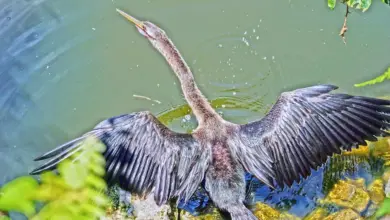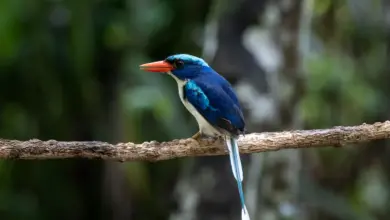How Many Birds Are There In The World? Millions?
How Many Birds Are There In The World? Millions? You’d be Shocked.
Look up at the sky, and it is clear that there are a large number of birds everywhere. But how many birds are there in the world exactly? What are our best estimates of bird population? How many types of birds are there? We look at all this and more.
Depending on which scientific study you refer to, the number of birds in the world is anywhere between 50 billion and 400 billion. In context, the human population on this planet is about eight billion.
Yes, you read that right, that’s in billions. Birds outnumber us many times over.
For example, in a study conducted by Gaston, K.J., and Blackburn in 1997, the estimated number of birds was between 200 billion to 400 billion.

In a more recent study conducted in 2021 (published under the Proceedings of the National Academy of Sciences) citizen bird enthusiasts, scientists, and data analytics professionals got together to put a number of about 50 billion individual birds on earth.
However, they also hedged their bets by saying that this is a median estimate, and the actual one could be as high as 428 billion!
While we may never know for sure what the real number is, one thing is for sure: the biodiversity of the avian kingdom is much more than we would think.
In this number-heavy article, we talk about the birds of the world, their types, which species dominate the earth, and why knowing these numbers is important.
How Many Species of Bird are in the World?
The current scientific consensus on the number of bird species ranges anywhere between 9,000 and 11,000. For example, the PNAS study we cited earlier puts this number at 9,700 wild bird species.
According to this resource from the Cornell Lab of Ornithology, the number of species is 10,824.
The International Ornithological Committee agrees with this number, putting the final figure at 11,001.
However, others disagree. According to the IUCN red list, as quoted by Our World in Data, the number of bird species described to date is over 11,000.

But since it is hard to observe and name every bird, they believe that this number is actually an underestimate.
The American Museum of National History believes the number is actually closer to 18,000!
However, this estimate uses a different methodology for classifying species – they identified species using their physical traits, rather than who can breed with whom.
To sum it up, we are not really sure about the number of bird species, let alone the actual count!
Which Countries Have The Highest Diversity of Bird Species?
While there is a huge variety of bird species, their spread across the world is not uniform.
Not all countries are equally blessed when it comes to birds. South America, often called the “bird continent” holds the Guinness world record for the maximum species of birds.
The table below depicts the top five countries in the world based on the number of species of birds that they have. Not surprisingly, four out of five are from South America.
| Country | Bird Species(count) | Land Area (sq. km) | Species Density (per 1,000 sq. km) | LandBirds | Migratory Birds | SeaBirds | WaterBirds | Breeding Endemic birds |
|---|---|---|---|---|---|---|---|---|
| Colombia | 1,878 | 1,141,748 | 1.64 | 1,671 | 326 | 53 | 165 | 94 |
| Peru | 1,858 | 1,285,216 | 1.45 | 1,646 | 341 | 70 | 172 | 139 |
| Brazil | 1,813 | 8,515,767 | 0.21 | 1,609 | 385 | 70 | 163 | 257 |
| Indonesia | 1,711 | 1,904,569 | 0.90 | 1,525 | 269 | 41 | 178 | 507 |
| Ecuador | 1,622 | 276,841 | 5.86 | 1,438 | 270 | 59 | 153 | 42 |
Sources: BirdLife International, Worldometer
What’s most surprising however is Ecuador. It has almost 6 different bird species to be found in every 1000 sq. km. Ecuador is indeed a haven for avian diversity and an ornithologist or bird lover’s dream.
Another thing to note is that all the top five countries are blessed with tropical rainforests – a habitat teeming with biodiversity.
Which Kinds of Birds Have the Largest Population?
While the overall bird population is huge as well as diverse, when it comes down to sheer numbers, only a handful of birds make the bulk of the avian kingdom.
Out of the estimated 50 billion world population of birds, the following 6 contribute nearly 14%:
| Bird Species | Population |
|---|---|
| House Sparrow | 1.6 billion |
| European Starling | 1.3 billion |
| Ring-billed Gulls | 1.2 billion |
| Barn Swallows | 1.1 billion |
| Glaucous Gulls | 949 million |
| Alder Flycatchers | 896 million |
Source: PNAS
Why Is It So Hard to Estimate Bird Species?
You might wonder why data analysts can count all 7.8 billion humans so precisely and accurately, but fail to track even bird species (not bird counts, just the species).
There are several reasons why this takes much more effort.
Species are discovered (and sadly go extinct) every year
The sad fact is that many bird species are going extinct every year. We know that human interventions like loss of habitat, climate change, and hunting are leading to biodiversity at an alarming rate.
The above reasons are leading to a loss of bird populations in the wild. But birds in urban settings also don’t have it particularly easy.
You might not be aware that millions (probably billions) of birds die each year because of collisions with buildings and windows or being hunted and eaten by pets or stray cats.
These are things that birds were never adapted to in millions of years of evolutionary history.
Because of these reasons estimating the number of bird species is a moving target for scientists.
On the other hand, happy incidents of new bird species being discovered are rarer but do add to the overall confusion regarding species count.
Accessibility is improving
Infrastructure such as new roads or bridges etc. may cause a loss in biodiversity but it also gives scientists the chance to explore areas where they were hitherto unable to reach. This helps them find new species as well.
Many areas in South America, especially the Amazon have become accessible in the last 25 years, helping us get a better look at the wide variety of flora and fauna that exists there.
Countries that were previously closed to the outer world (such as Vietnam during the war) present new avenues for exploration when they start to open themselves.

Citizen scientists and birdwatchers are increasing in numbers
With birdwatching blowing up as a popular hobby, there are 70 million people to observe more species and identify new ones.
Moreover, as our phone cameras improve and become more ubiquitous, there are higher resolution and clearer pictures of birds available online for scientists to observe and classify.
The Study of Taxonomy Is Becoming More Advanced
As more and more species get discovered, the study of the classification of animal life gets more advanced. The data available for classification and comparison is becoming richer.
For example, the Canada Goose, long considered to be a single species was reclassified in 2004 into 2 different species: the Canada Goose and the Cackling Goose.
Moreover, artificial intelligence and data analytics are getting involved in taxonomy, making the classification and identification of species an easier job.
Is the Bird Population Growing?
Sadly, no.
Nearly 180 species of birds have disappeared from the earth in the last 500 years. With this rate of extinction, the bird population is certainly not growing in diversity.
Moreover, more than 4,000 species are currently tagged as facing the threat of extinction.
Unsurprisingly, the countries with the highest number of bird species also feature in the list of countries with the highest number of threatened species:

Source: International Union for Conservation of Nature (via World Bank). OurWorldInData.org/biodiversityCC BY 4.0
The trend of extinction is not limited to birds, but to all major life forms on earth. Despite their huge diversity, nearly 13% of bird species are facing extinction today

Studies suggest that by the year 2100, between 10-20% of all bird species known today would go extinct.
Why Are Bird Numbers Going Down So Drastically?
There are two main reasons that are causing this huge decline in numbers: large-scale deforestation and climate change.
Deforestation & Habitat Conversion
Deforestation is leading to a lack of sustainable homes for terrestrial birds, which is causing them to go extinct.
Many erstwhile havens for bird habitation such as rainforests in the tropical latitudes are losing out to human development.

Climate Change
Climate change is likely to become the single largest factor driving extinction of animal and bird species post the year 2050.
As global warming raises temperatures, many species of animals simply cannot sustain themselves any longer.
Both climate change and deforestation are inextricably intertwined. Stopping deforestation, especially in the tropical rainforests is key to controlling global warming as well.
In the past, human intervention has led to mass-scale extinctions of bird species in places such as French Polynesia and Hawaii.
The Role of Birds in the Ecosystem: Why We Need Birds
Birds perform several key roles in the ecosystem, which makes their survival extremely important for all life on earth. Understanding these functions is critical to helping people understand their importance.
Pollinators for plants
Honeyeaters, Hummingbirds, sunbirds, and other nectar-eating birds help in pollinating certain species of plants. Bats are also responsible for pollinating some plants.
Seed dispersers
Perhaps the most important role of birds in the ecosystem is to transport and disperse seeds. By dispersing seeds, birds help protect these life-giving seeds from predators and herbivores.

Scavengers of dead animals
You might think of scavenging as a bad thing to do, but it has many benefits to the ecosystem. Scavenging helps decompose the carcass and recycle its nutrients.
It also helps reduce the spread of disease from germs and bacteria that reside in a carcass.
For example, vultures, one of the main scavengers in the avian family have a great capacity to resist and neutralize bacterial toxins. Their stomach acids have a very high pH, which kills spores and several bacteria.
Crop protectors
As natural predators of insects that might destroy crops, birds help protect crops. Research has played down its role in controlling the insect population in temperate climates where insect outbreaks are sudden and cyclical.
However, there is evidence to suggest that they are year-round protectors of plant life in the tropics, where insect populations are steady and don’t change much.

Wrap Up
Birds are vital to our long-term survival. While their population may be much bigger than that of humans, the numbers are concentrated in certain species.
However, each bird has a unique role in the ecology of the place where it lives. Therefore, it is important to understand that we need to protect all species of birds, not just overall bird numbers.
Reducing deforestation and pollution, as well as aggressively marking major bird habitats as no development zones will help control the decline in their species diversity.




Nice. Wherever I am, I can hear birds chirping or see flocks of birds flying overhead. This has led some to ask how many birds are in the world. Thanks for you answer.